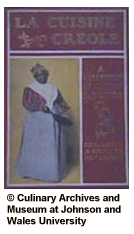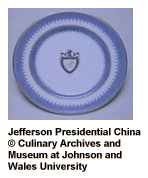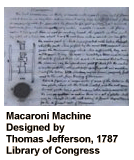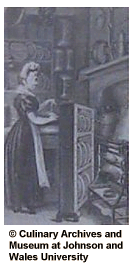1776-1799
1777 Declaration of Independence; Articles of Confederation adopted by Continental Congress; Terrible winter at Valley Forge, Pennsylvania;
1781 American Revolution ends; British surrender at Yorktown;
1783 Treaty of Paris signed by U.S. and Great Britain;
1787 Northwest Ordinance enacted by Congress;
1789 First session of the U.S. Congress; George Washington inaugurated President of the United States; Thanksgiving Day celebrated for first time as a national holiday;
1790 First U.S. Census authorized by Congress;
1793 Cotton gin patented (Eli Whitney);
1796 Amelia Simmons' cookbook;
1798 First manufacturing of interchangeable parts (to produce firearms).
1800-1810
1800 Library of Congress established; four-tined forks in common use; Washington D.C. becomes capital of United States;
1801 Johnny Appleseed;
1803 Louisiana Purchase (from France for $15,000,000);
1804 Lewis and Clark expedition; First automobile built (Oliver Evans);
1806 Exploration of southwestern territory (Zebulon Pike); First street lighting (gas lights);
1807 Trade in slaves prohibited by Congress; First steamboat run from New York to Albany (Robert Fulton);
1808 Start of Napoleonic War (between England and France).
1811-1820
1811 Strongest earthquake in America (New Madrid, Missouri);
1812 Lead pencils first produced in America; War of 1812 proclaimed (June 18th);
1813 Battle of Lake Erie;
1815 Contestoga wagon (prairie schooner) developed;
1817 Public school for the deaf founded (Thomas Gallaudet); Erie Canal construction begins;
1818 Tin can introduced to America (Peter Durand); First scheduled Trans-Atlantic ship crossings between U.S. and England;
1819 Florida purchased from Spain; First food canning business (New York City).
 The combination of red beans and rice is associated with Louisiana and usually is kidney beans and rice flavored with ham? This traditional Creole dish is served on Monday and originated in southern Louisiana. When served with salad, red beans and rice is a complete, economical meal. [3: 8]
The combination of red beans and rice is associated with Louisiana and usually is kidney beans and rice flavored with ham? This traditional Creole dish is served on Monday and originated in southern Louisiana. When served with salad, red beans and rice is a complete, economical meal. [3: 8]
 The tomato was first domesticated in Mexico? Tomatoes were transported to Europe in the 16th century as ornamental plants -- not to be eaten -- since they were considered poisonous by most Europeans. Thomas Jefferson kept a detailed diary of his gardening activities and an entry from his log reveals that he planted tomatoes at his Virginia home in 1781 [3: 9]
The tomato was first domesticated in Mexico? Tomatoes were transported to Europe in the 16th century as ornamental plants -- not to be eaten -- since they were considered poisonous by most Europeans. Thomas Jefferson kept a detailed diary of his gardening activities and an entry from his log reveals that he planted tomatoes at his Virginia home in 1781 [3: 9]
 Food stores inside the Alamo at the time of the battle in 1836 consisted of approximately ninety bushels of corn, and twenty to thirty head of cattle? Scholars suggest that breakfast at the Alamo consisted of corn and beef, while lunch was beef and corn, and the supper meal was probably corn and beef. [3: 10]
Food stores inside the Alamo at the time of the battle in 1836 consisted of approximately ninety bushels of corn, and twenty to thirty head of cattle? Scholars suggest that breakfast at the Alamo consisted of corn and beef, while lunch was beef and corn, and the supper meal was probably corn and beef. [3: 10]
 Thomas Jefferson introduced the waffle iron to America? He also introduced Neapolitan "macaroni" (i.e. spaghetti) to America and served "French fries" with beefsteak. Some say that while he was in France, Jefferson obtained recipes for ice cream, although Dolly Madison frequently gets credit for introducing ice cream to the White House. [3: 11]
Thomas Jefferson introduced the waffle iron to America? He also introduced Neapolitan "macaroni" (i.e. spaghetti) to America and served "French fries" with beefsteak. Some say that while he was in France, Jefferson obtained recipes for ice cream, although Dolly Madison frequently gets credit for introducing ice cream to the White House. [3: 11]
 The vegetable okra is native to western Africa? The English word, gumbo, stems from ochinggombo, an African baNtu term for okra. Gumbo as an English word probably appears first in 1805. [3: 12]
The vegetable okra is native to western Africa? The English word, gumbo, stems from ochinggombo, an African baNtu term for okra. Gumbo as an English word probably appears first in 1805. [3: 12]
At the conclusion of the Revolutionary War, the British shipped all the rice out of the former Carolina colonies and also took with them the seed rice? In order to counter a potential famine, Thomas Jefferson smuggled rice out of Italy and is responsible for restarting the Carolina rice industry. [3:13]
Friendly Native Americans taught pioneers crossing the American desert to eat insects? Hungry pioneers fried Rocky Mountain locusts in oil until crisp, then seasoned them with salt. One recipe for locust stew was: Boil prepared Rocky Mountain locusts in salted water. Add assorted cut-up vegetables, butter, salt, and vinegar to the broth and cook until the vegetables are tender. Serve as thick soup or over boiled rice as a main dish. [3: 14]
 In 1837 a young Vermont blacksmith, John Deere, developed a plow that could clean, scour, and polish itself? This plow made it possible to convert the western prairies into vast fields of corn and wheat. [3: 15]
In 1837 a young Vermont blacksmith, John Deere, developed a plow that could clean, scour, and polish itself? This plow made it possible to convert the western prairies into vast fields of corn and wheat. [3: 15]
1821-1830
1821 First American settlement in Texas (San Felipe de Austin); Coffee accepted into general use;
1823 Monroe Doctrine enunciated by President James Monroe;
1824 Gateway through Rocky Mountains identified (Jedediah Smith); Sequoyah develops first American Indian written language (Cherokee);
1826 First railway steam locomotive built in America; First design for internal combustion engine;
1829 Typewriter patented;
1830 Invention of the T-rail for railroad track; First birth control book published in America.
1831-1839
1831 Invention of mechanical reaper (Cyrus McCormick);
1832 Oranges and lemons shipped from Sicily to America;
1833 Colt revolver invented;
1834 Electric motor invented (Thomas Davenport);
1835 Telegraph invented (Samuel Morse); Return of Halley's comet;
1836 Texas declared an independent republic; Alamo mission at San Antonio attacked by General Santa Anna (March 6th); Santa Anna defeated at battle of San Jacinto (April 21st);
1837 Invention of steel plow;
1838 Transportation of fugitive slaves to freedom via the Underground Railroad; Forced removal of the Cherokee Indians (Trail of Tears);
1839 First daguerreotype portraits taken in America; Vulcanized rubber invented by Charles Goodyear.
1840-1848
1840 Ten-hour work-day established;
1841 First wagon train to California;
1842 Fremont expedition explores route to Oregon; Children under 12 years of age limited to a 10-hour work day;
1843 Oregon Trail opened;
1844 First telegraph message transmitted ("What hath God wrought");
1845 Fremont expedition to California; Baseball rules refined (Alexander Cartwright);
1846 Mormon migration west; Mexican War begins; Bear Flag Revolt (California); Sewing machine patented (Elias Howe); Anesthesia demonstrated; First recorded baseball game (Elysian Field, Hoboken, New Jersey);
1847 Donner party disaster; Mormon emigrants arrive in Utah, Salt Lake City founded; Stamps first issued by Post Office Department;
1848 Gold discovered in California.